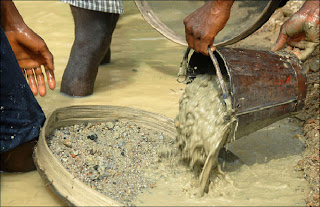
 In KOIDU, Sierra Leone. The tiny stone settled into the calloused grooves of Tambaki Kamanda’s palm, its dull yellow glint almost indiscernible even in the noontime glare.It was the first stone he had found in days, and he expected to get little more than a dollar for it. It hardly seemed worth it, he said — after days spent up to his haunches in mud, digging, washing, searching the gravel for diamonds. Farming had brought no money for clothes or schoolbooks for his two wives and five children. He could find no work as a mason. “I don’t have choice,” Mr. Kamanda said, standing calf-deep in brown muddy water here at the Bondobush mine, where he works every day. “This is my only hope, really.”
In KOIDU, Sierra Leone. The tiny stone settled into the calloused grooves of Tambaki Kamanda’s palm, its dull yellow glint almost indiscernible even in the noontime glare.It was the first stone he had found in days, and he expected to get little more than a dollar for it. It hardly seemed worth it, he said — after days spent up to his haunches in mud, digging, washing, searching the gravel for diamonds. Farming had brought no money for clothes or schoolbooks for his two wives and five children. He could find no work as a mason. “I don’t have choice,” Mr. Kamanda said, standing calf-deep in brown muddy water here at the Bondobush mine, where he works every day. “This is my only hope, really.” Diamond mining in Sierra Leone is no longer the bloody affair made infamous by the nation’s decade-long civil war, in which diamonds played a role. The diamond conflict (blood diamond) - begun by rebels who claimed to be ridding the mines of foreign control - killed 50,000 people, forced millions to flee their homes, destroyed the country’s economy and shocked the world with its images of amputated limbs and drug-addled boy soldiers. An international regulatory system created after the war has prevented diamonds from fueling conflicts and financing terrorist networks.
Diamond mining in Sierra Leone is no longer the bloody affair made infamous by the nation’s decade-long civil war, in which diamonds played a role. The diamond conflict (blood diamond) - begun by rebels who claimed to be ridding the mines of foreign control - killed 50,000 people, forced millions to flee their homes, destroyed the country’s economy and shocked the world with its images of amputated limbs and drug-addled boy soldiers. An international regulatory system created after the war has prevented diamonds from fueling conflicts and financing terrorist networks.Regardless of that matter, diamond mining in Sierra Leone remains a grim business that brings the government far too little revenue to right the devastated country, yet feeds off the desperation of some of the world’s poorest people. “The process is more to sanitize the industry from the market side rather than the supply side,” said John Kanu, a policy adviser to the Integrated Diamond Management Program, a United States-backed effort to improve the government’s handling of diamond money. “To make it so people could go to buy a diamond ring and to say, ‘Yes, because of this system, there are no longer any blood diamonds. So my love, and my conscience, can sleep easily.’ “But that doesn’t mean that there is justice,” he said. “That will take a lot, lot longer to change.”
 In many cases, the vilified foreign mine owners have simply been replaced by local elites with a firm grip on the industry’s profits. At the losing end are the miners here in Kono District, who work for little or no pay, hoping to strike it rich but caught in a net of semifeudal relationships that make it all but impossible that they ever will. A vast majority of Sierra Leone’s diamonds are mined by hand from alluvial deposits near the earth’s surface, so anyone with a shovel, a bucket and a sieve can go into business; and in a country with few formal jobs, at least 150,000 people work as diggers, government officials said.
In many cases, the vilified foreign mine owners have simply been replaced by local elites with a firm grip on the industry’s profits. At the losing end are the miners here in Kono District, who work for little or no pay, hoping to strike it rich but caught in a net of semifeudal relationships that make it all but impossible that they ever will. A vast majority of Sierra Leone’s diamonds are mined by hand from alluvial deposits near the earth’s surface, so anyone with a shovel, a bucket and a sieve can go into business; and in a country with few formal jobs, at least 150,000 people work as diggers, government officials said.
1 comment:
Great post!!! Thanks for your information,and it will help the visitors to know something more from you, which is good....
Post a Comment